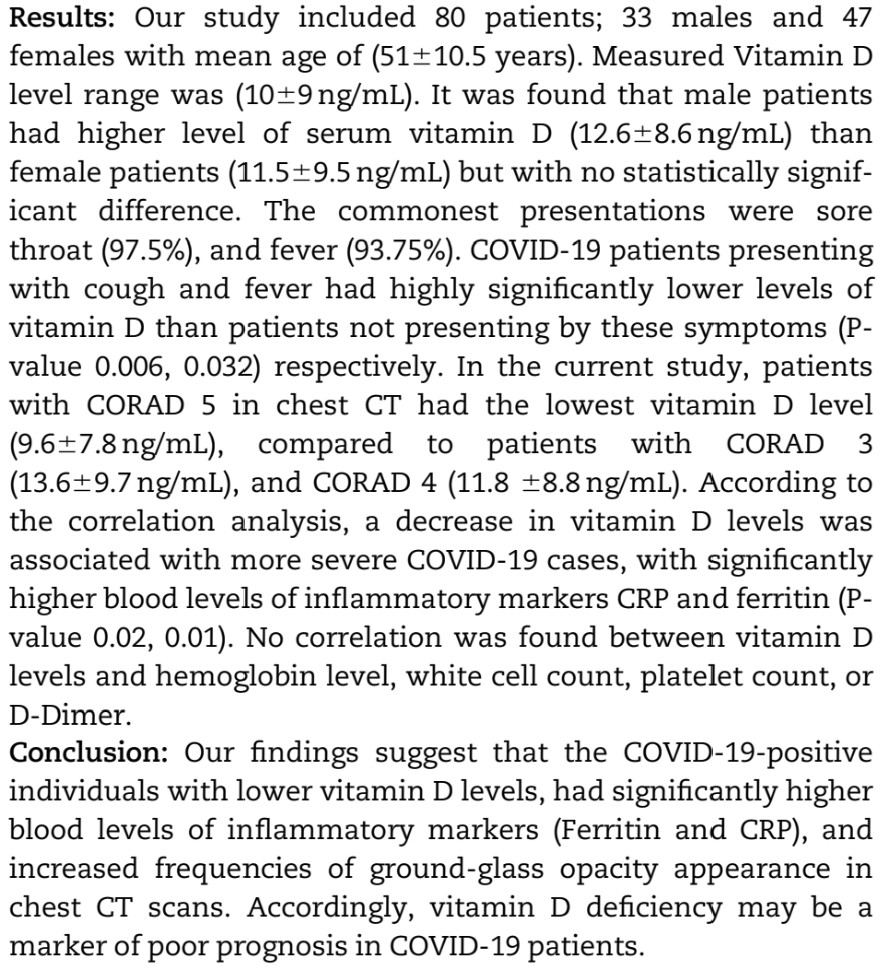
Measurement of Vitamin D Level among Covid-19 Patients and its Correlation with Severity of the Disease
et al., QJM: An International Journal of Medicine, doi:10.1093/qjmed/hcae070.291, Jun 2024
Vitamin D for COVID-19
8th treatment shown to reduce risk in
October 2020, now with p < 0.00000000001 from 136 studies, recognized in 18 countries.
No treatment is 100% effective. Protocols
combine treatments.
6,300+ studies for
210+ treatments. c19early.org
|
Retrospective 80 COVID-19 patients showing that patients with the most severe chest CT findings had the lowest average vitamin D levels. Patients with lower vitamin D levels had significantly higher levels of inflammatory markers (CRP and ferritin) and were more likely to present with cough and fever.
Morad et al., 1 Jun 2024, retrospective, peer-reviewed, 4 authors.
DOI record:
{
"DOI": "10.1093/qjmed/hcae070.291",
"ISSN": [
"1460-2725",
"1460-2393"
],
"URL": "http://dx.doi.org/10.1093/qjmed/hcae070.291",
"abstract": "<jats:title>Abstract</jats:title>\n <jats:sec>\n <jats:title>Background</jats:title>\n <jats:p>Coronavirus disease 2019 (covid-19) is defined as illness caused by a novel coronavirus now called severe acute respiratory syndrome coronavirus 2 (SARS-CoV-2), which was first identified among an outbreak of respiratory illness cases in Wuhan City, China. Vitamin D is known to play a key role in the maintenance of bone health and calcium–phosphorus metabolism, yet many other functions of this vitamin have been recently postulated, such as modulation of the immune response in both infectious and autoimmune diseases. Different studies showed that severity of covid-19 infection is directly related to vitamin D level.</jats:p>\n </jats:sec>\n <jats:sec>\n <jats:title>Methods</jats:title>\n <jats:p>This is an observational cross-sectional study, which includes 80 COVID-19 patients, and admitted in the ward and ICU of EL Medany Hospital, EL Demerdash and EL Obour specialized hospital. All patients had positive PCR for COVID-19. Chest CT without contrast was done for all patients and categorized according to CORAD staging. Serum vitamin D level was measured, besides laboratory inflammatory markers (CRP, ferritin, d-dimer), kidney and liver function tests, and complete blood picture.</jats:p>\n </jats:sec>\n <jats:sec>\n <jats:title>Results</jats:title>\n <jats:p>Our study included 80 patients; 33 males and 47 females with mean age of (51±10.5 years). Measured Vitamin D level range was (10±9 ng/mL). It was found that male patients had higher level of serum vitamin D (12.6±8.6 ng/mL) than female patients (11.5±9.5 ng/mL) but with no statistically significant difference. The commonest presentations were sore throat (97.5%), and fever (93.75%). COVID-19 patients presenting with cough and fever had highly significantly lower levels of vitamin D than patients not presenting by these symptoms (P-value 0.006, 0.032) respectively. In the current study, patients with CORAD 5 in chest CT had the lowest vitamin D level (9.6±7.8 ng/mL), compared to patients with CORAD 3 (13.6±9.7 ng/mL), and CORAD 4 (11.8 ±8.8 ng/mL). According to the correlation analysis, a decrease in vitamin D levels was associated with more severe COVID-19 cases, with significantly higher blood levels of inflammatory markers CRP and ferritin (P-value 0.02, 0.01). No correlation was found between vitamin D levels and hemoglobin level, white cell count, platelet count, or D-Dimer.</jats:p>\n </jats:sec>\n <jats:sec>\n <jats:title>Conclusion</jats:title>\n <jats:p>Our findings suggest that the COVID-19-positive individuals with lower vitamin D levels, had significantly higher blood levels of inflammatory markers (Ferritin and CRP), and increased frequencies of ground-glass opacity appearance in chest CT scans. Accordingly, vitamin D deficiency may be a marker of poor prognosis in COVID-19 patients.</jats:p>\n </jats:sec>",
"author": [
{
"affiliation": [
{
"name": "Internal Medicine, Gastroenterology and Hepatology Department, Faculty of Medicine, Ain Shams University"
}
],
"family": "Morad",
"given": "Caroline",
"sequence": "first"
},
{
"affiliation": [
{
"name": "Internal Medicine, Gastroenterology and Hepatology Department, Faculty of Medicine, Ain Shams University"
}
],
"family": "Habeeb",
"given": "Reem",
"sequence": "additional"
},
{
"affiliation": [
{
"name": "Internal Medicine, Gastroenterology and Hepatology Department, Faculty of Medicine, Ain Shams University"
}
],
"family": "Yassin",
"given": "Esraa",
"sequence": "additional"
},
{
"affiliation": [
{
"name": "Internal Medicine, Gastroenterology and Hepatology Department, Faculty of Medicine, Ain Shams University"
}
],
"family": "Khalil",
"given": "Salma",
"sequence": "additional"
}
],
"container-title": "QJM: An International Journal of Medicine",
"content-domain": {
"crossmark-restriction": false,
"domain": []
},
"created": {
"date-parts": [
[
2024,
7,
3
]
],
"date-time": "2024-07-03T15:12:55Z",
"timestamp": 1720019575000
},
"deposited": {
"date-parts": [
[
2024,
7,
3
]
],
"date-time": "2024-07-03T15:12:56Z",
"timestamp": 1720019576000
},
"indexed": {
"date-parts": [
[
2024,
7,
4
]
],
"date-time": "2024-07-04T00:24:32Z",
"timestamp": 1720052672351
},
"is-referenced-by-count": 0,
"issue": "Supplement_1",
"issued": {
"date-parts": [
[
2024,
6,
1
]
]
},
"journal-issue": {
"issue": "Supplement_1",
"published-online": {
"date-parts": [
[
2024,
7,
3
]
]
},
"published-print": {
"date-parts": [
[
2024,
7,
3
]
]
}
},
"language": "en",
"license": [
{
"URL": "https://academic.oup.com/pages/standard-publication-reuse-rights",
"content-version": "vor",
"delay-in-days": 0,
"start": {
"date-parts": [
[
2024,
6,
1
]
],
"date-time": "2024-06-01T00:00:00Z",
"timestamp": 1717200000000
}
}
],
"link": [
{
"URL": "https://academic.oup.com/qjmed/article-pdf/117/Supplement_1/hcae070.291/58413629/hcae070.291.pdf",
"content-type": "application/pdf",
"content-version": "vor",
"intended-application": "syndication"
},
{
"URL": "https://academic.oup.com/qjmed/article-pdf/117/Supplement_1/hcae070.291/58413629/hcae070.291.pdf",
"content-type": "unspecified",
"content-version": "vor",
"intended-application": "similarity-checking"
}
],
"member": "286",
"original-title": [],
"prefix": "10.1093",
"published": {
"date-parts": [
[
2024,
6,
1
]
]
},
"published-online": {
"date-parts": [
[
2024,
7,
3
]
]
},
"published-other": {
"date-parts": [
[
2024,
6,
1
]
]
},
"published-print": {
"date-parts": [
[
2024,
7,
3
]
]
},
"publisher": "Oxford University Press (OUP)",
"reference-count": 0,
"references-count": 0,
"relation": {},
"resource": {
"primary": {
"URL": "https://academic.oup.com/qjmed/article/doi/10.1093/qjmed/hcae070.291/7705193"
}
},
"score": 1,
"short-title": [],
"source": "Crossref",
"subject": [],
"subtitle": [],
"title": "Measurement of Vitamin D Level among Covid-19 Patients and its Correlation with Severity of the Disease",
"type": "journal-article",
"volume": "117"
}
